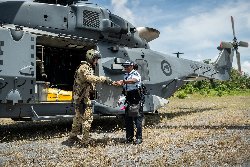Cablegate: Chemical Weapons Convention (Cwc): Guidance
O 160039Z OCT 08
FM SECSTATE WASHDC
TO AMEMBASSY THE HAGUE IMMEDIATE
UNCLAS STATE 110387
SIPDIS
THE HAGUE FOR THE CWC DEL
E.O. 12958: N/A
TAGS: PARM MARR KTIA CWC JA
SUBJECT: CHEMICAL WEAPONS CONVENTION (CWC): GUIDANCE
FOR DISCUSSIONS WITH THE TECHNICAL SECRETARIAT ON
SAMPLING AND ANALYSIS DURING SCHEDULE 2 INSPECTIONS
References: (A) The Hague 00180. (B) Technical
Secretariat letter L/VER/IVB/140324/08 dated 01 October
2008. (C) (06) State 145877.
1. Guidance in paragraphs 7-8.
----------
Overview
----------
2. This cable provides information and guidance to the
U.S. delegation for use during informal discussions with
the Technical Secretariat on the margins of EC-54, 14-17
October 2008. These sampling and analysis discussions
are a follow-up to a 19 February 2008 meeting (ref A) on
future sampling and analysis activities during Schedule
2 inspections, and the Technical Secretariat response
(ref B) to written questions posed in U.S. National
Authority letter (NACS#176650) dated August 28, 2008.
----------
Background
----------
3. An inspection team from the Technical Secretariat (TS)
of the Organization for the Prohibition of Chemical
Weapons (OPCW) conducted sampling and analysis
activities in the United States during a routine
Schedule 2 inspection in November 2007. This inspection
was one in a series of inspections involving sampling
and analysis that the TS conducted in numerous States
Parties during an 18-month trial period. Though a sample
was successfully taken and analyzed during the U.S.
inspection, concerns were raised by the U.S. Host Team
(HT) regarding the rationale for the sampling and the
scope of the analysis.
4. Participating States Parties met with the TS on 19
February to discuss their experiences with the sampling
and analysis inspections during the trial period. The
meeting did not allow for an in-depth discussion on the
rationale and efficacy of sampling and analysis so the
U.S. put down some markers concerning future sampling
and analysis activities during routine Schedule 2
inspections and the need for further U.S.-TS
discussions.
5. The delegation should bear in mind that the USG
considers sampling and analysis to be an inspection tool
that is intrusive, yet potentially valuable. In our
view, however, it is not sufficient for the inspection
team to simply cite Paragraph 27 of Part VII of the
Verification Annex as the justification for requesting a
sample. A request by the inspection team to conduct
sampling and analysis activities should be directly
linked and relevant to (1) the inspection mandate and
(2) site-specific risks, as provided for in paragraph 20
("... in deciding on the ... intensity of the inspections,
the Technical Secretariat shall give due consideration
to the risk to the object and purpose of this Convention
posed by the relevant chemical, the characteristics of
the plant site and the nature of the activities carried
out there, taking into account the respective facility
agreement as well as the results of the initial
inspections and subsequent inspections"). Before
requesting a sample, the team should consider whether
less intrusive means, including those proposed by the
inspected State Party, would allow it to fulfill its
mandate. However, sampling and analysis is only one of
several inspection tools and use of this intrusive tool
during Schedule 2 inspections in the U.S. should require
a rationale beyond simply invoking paragraph 27 even for
sampling and analysis in the declared plant(s) that is
the focus of the inspection. Further, an inspection
team's having brought the sampling and analysis
equipment does not mean that they must employ it and
thus its use should not be required in the inspection
mandate. The delegation should also bear in mind that,
per (ref C), "the U.S. expects the TS to...identify
reasons during the inspection period as to why
taking/analyzing samples is necessary."
6. On August 29, 2008 the U.S. delegation delivered a
letter to the Technical Secretariat containing questions
to help frame the issues. On October 3, 2008 we
received the Secretariat's response. The questions and
answers are outlined below:
Q1. For any given Schedule 2 facility, what does the TS
consider constitutes a rationale or basis for sampling
and analysis? What criteria would be used in deciding
whether or not to request a sample?
A1. In the Secretariat's view, the rationale and the
basis to conduct S&A is clearly spelled out in Part VII,
paragraph 27 of the Verification Annex which states that
"sampling and analysis shall be undertaken to check for
the absence of undeclared scheduled chemicals." The CWC
therefore obligates the Secretariat to use this unique
verification tool (i.e., sampling and analysis) during
all Schedule 2 inspections.
Q2. Does the TS agree that Paragraph 27 should not be
cited as the sole grounds for requesting a sample? If
the TS view differs from the U.S. view, how does it
differ?
A2. In the opinion of the Secretariat and according to
the text of the CWC, paragraph 27 provides sufficient
grounds for requesting a sample to carry out S&A.
Q3. In the event of an anomalous analysis result (e.g.,
the detection of one or more undeclared scheduled
chemicals) how would the Inspection Team resolve the
result and to what degree, if any, would the burden be
on the inspected facility? Can a more extensive
spectral database than the OCAD be used in the blinded
mode, or is this possibility only available in the open
mode?
A3. In the event of an anomalous result, such as
detecting some undeclared scheduled chemicals, the
Inspection Team would work closely with the ISP
representatives as well as technical personnel from the
inspected site to find a technical explanation for this
type of result. In cases where the analytical results
are different from what was anticipated, the Inspection
Team has been able to work with the ISP in order to
identify the appropriate explanation. Currently, an
extensive commercial database can only be accessed from
GC/MS working in open mode. However, the Secretariat is
already working on the development of a "new blinded"
operating mode, which, in essence, is a blinded mode
that would allow access to a commercial library [of
chemicals]. The new operating mode is expected to be
available as of next year.
Q4. How often have "false positives" been encountered?
What has caused them?
A4. Out of the eighteen Schedule 2 inspections conducted
so far involving S&A, eleven of them reported GC/MS
matches with the OCAD. An undeclared scheduled chemical
showed up on one mission. In the remaining ten
missions, there were matches with OCAD reported as
"false positives." In one of the ten missions which had
"false positives" there were also scheduled chemicals
reported at low levels. Of the ten missions in which
"false positives" were reported, eight were clarified
using the differences in the retention indices and/or
spectral analysis. In two cases, the IT in agreement
with ISP, accessed the commercial library to discard the
identification as being an undeclared scheduled
chemical.
Q5. Does the Technical Secretariat envisage an end-state
in which sampling and analysis equipment is routinely
taken on industry inspections and used only if less
intrusive means are unable to achieve the inspection
aims? And if the TS view differs from this end-state,
how does it differ?
A5. As indicated in the response provided in the
introductory paragraphs, the Secretariat was not given
the latitude of choosing which verification tool to use
during Schedule 2 inspections. The use of access to
records does not exclude the use of access to the
declared plant(s) or other parts of the plant site.
Neither does it exclude the sampling and analysis which
according to Paragraph 27 of part VII of the VA "shall
be undertaken." This provision of the Convention does
not specify any limitations or special circumstances for
the use of S&A. Therefore, the Secretariat regards S&A
for Schedule 2 inspections as a routine tool to be used
during the inspection process - the same as it is for
the physical inspection of facilities or the checking of
records. S&A is the most direct method to check for the
absence of undeclared scheduled chemicals and provides a
higher degree of assurance that the plant site is in
compliance with the CWC.
--------
Guidance
--------
7. Delegation should explore in depth TS views on
sampling and analysis during Schedule 2 inspections.
Del should draw on background above regarding U.S. views
and on the additional points in paragraph 10 during
discussions with the Technical Secretariat.
8. Please report results of the discussions by cable to
Washington.
9. Please contact ISN/CB - Richard D'Andrea at (202)647-
5091 or via email with any questions.
-----------------
Additional Points
-----------------
10. Begin Additional Points
- Given the inspection team's obligation under the
Confidentiality Annex to "...take into consideration
proposals which may be made by the [inspected] State
Party...to ensure that sensitive equipment or
information...is protected," if a host team offered an
alternative, protective proposal, would such a proposal
be given serious consideration by the inspection team?
- The OPCW has long recognized the value of the
partnership with the chemical industry, and the DG
reiterated this during the Second Review Conference.
Probably more than any other inspection tool, the U.S.
chemical industry would like to be sure that the
Secretariat is using sampling and analysis in a measured
way, building on previous inspection successes.
- Given that the inspection-related disagreements
encountered during the early industry inspections in the
U.S. were successfully overcome, we have every
expectation that sampling and analysis issues can be
similarly resolved. What do you think would be the best
way to do this?
- The TS view in the 1 October letter appears to go
beyond in some cases what is necessary or practical from
a verification standpoint.
- Is it the TS goal that eventually every Schedule 2
inspection should involve sampling and analysis?
- When will the "new blinded" operating mode for the
GC/MS be available next year?
RICE
NNNN
End Cable Text


 UN News: Healing Page By Page In Earthquake-affected Türkiye
UN News: Healing Page By Page In Earthquake-affected Türkiye Save The Children: Rate Of Attacks On Healthcare in Gaza Higher Than In Any Other Conflict Since 2018
Save The Children: Rate Of Attacks On Healthcare in Gaza Higher Than In Any Other Conflict Since 2018 UN News: Green Light For New Cholera Vaccine, Ukraine Attacks Condemned, Action Against Racism
UN News: Green Light For New Cholera Vaccine, Ukraine Attacks Condemned, Action Against Racism Laureus: Grand Slam Champion Garbiñe Muguruza Announces Retirement Ahead Of Laureus World Sports Awards
Laureus: Grand Slam Champion Garbiñe Muguruza Announces Retirement Ahead Of Laureus World Sports Awards Carbon Market Watch: Going For Green - Is The Paris Olympics Winning The Race Against The Climate Clock?
Carbon Market Watch: Going For Green - Is The Paris Olympics Winning The Race Against The Climate Clock? New Zealand Defence Force: NZDF Working With Pacific Neighbours To Support Solomon Islands Election
New Zealand Defence Force: NZDF Working With Pacific Neighbours To Support Solomon Islands Election